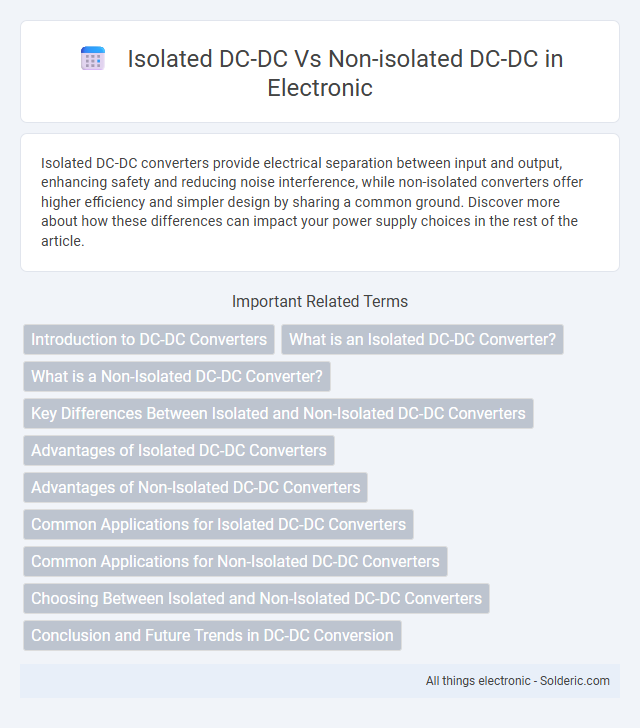Isolated DC-DC converters provide electrical separation between input and output, enhancing safety and reducing noise interference, while non-isolated converters offer higher efficiency and simpler design by sharing a common ground. Discover more about how these differences can impact your power supply choices in the rest of the article.
Comparison Table
| Feature | Isolated DC-DC Converter | Non-Isolated DC-DC Converter |
|---|---|---|
| Electrical Isolation | Provides galvanic isolation using transformers or optocouplers | No electrical isolation; direct electrical connection between input and output |
| Safety | Higher safety, suitable for medical, industrial, and high-voltage applications | Lower safety; typically used in low-voltage, less hazardous environments |
| Complexity | More complex circuit design with additional components (transformers, optocouplers) | Simpler design with fewer components, easier to implement |
| Size and Cost | Generally larger size and higher cost due to isolation components | Compact size and lower cost |
| Efficiency | Typically lower efficiency due to additional isolation stages | Higher efficiency because of fewer energy conversion steps |
| Typical Applications | Industrial automation, medical devices, telecommunications, power supplies needing isolation | Battery-powered devices, DC motor drives, point-of-load regulation |
| Voltage Conversion Range | Supports wide input/output voltage ranges due to transformer isolation | Limited by input/output voltage compatibility; no isolation benefits |
Introduction to DC-DC Converters
DC-DC converters efficiently transform voltage levels between different parts of electronic systems, enhancing power management. Isolated DC-DC converters provide galvanic isolation between input and output, ensuring safety and noise reduction, while non-isolated types directly connect input and output grounds for higher efficiency and smaller size. Your choice depends on application requirements like isolation needs, efficiency, size, and cost.
What is an Isolated DC-DC Converter?
An isolated DC-DC converter uses transformers or optocouplers to provide galvanic isolation between its input and output, ensuring that no direct electrical connection exists. This isolation improves safety by preventing ground loops and reducing noise interference, making it suitable for sensitive electronics and medical devices. Your choice between isolated and non-isolated converters depends on the need for electrical isolation, system complexity, and application-specific requirements.
What is a Non-Isolated DC-DC Converter?
A non-isolated DC-DC converter is an electronic circuit that directly connects the input and output grounds, allowing energy transfer without galvanic isolation. It efficiently steps voltage up or down within the same reference potential using components such as Buck, Boost, or Buck-Boost topologies. These converters are commonly used in applications requiring compact size, low cost, and high efficiency but lack the safety benefits of isolation found in isolated converters.
Key Differences Between Isolated and Non-Isolated DC-DC Converters
Isolated DC-DC converters provide galvanic isolation between input and output through a transformer, enhancing safety and reducing noise interference in sensitive applications. Non-isolated DC-DC converters directly connect the input and output grounds, offering higher efficiency, smaller size, and lower cost but without isolation benefits. Choosing between the two depends on your system's safety requirements, electromagnetic compatibility, and power regulation needs.
Advantages of Isolated DC-DC Converters
Isolated DC-DC converters provide galvanic isolation between input and output, enhancing safety and reducing noise interference in sensitive applications. Their ability to break ground loops ensures improved electromagnetic compatibility and protects your devices from voltage spikes. These converters are ideal for industrial and medical equipment requiring strict isolation standards and improved system reliability.
Advantages of Non-Isolated DC-DC Converters
Non-isolated DC-DC converters offer higher efficiency and lower cost by eliminating the need for bulky transformers, making them ideal for applications where electrical isolation is not critical. Their compact design and simpler circuitry reduce size and weight, enhancing reliability and ease of integration into Your electronic systems. These converters provide faster transient response and improved power density, optimizing performance in battery-powered and portable devices.
Common Applications for Isolated DC-DC Converters
Isolated DC-DC converters are commonly used in medical devices, telecommunications, and industrial automation to provide galvanic isolation and protect sensitive equipment from high voltage spikes. They are essential in applications requiring safety compliance and noise reduction, such as power supplies for medical imaging equipment and telecom base stations. The isolation barrier enhances system reliability by preventing ground loops and ensuring signal integrity in harsh environments.
Common Applications for Non-Isolated DC-DC Converters
Non-isolated DC-DC converters are frequently used in applications requiring efficient voltage regulation within the same ground reference, such as in battery-powered devices, point-of-load voltage regulation in microprocessors, and power supply modules for telecommunications equipment. These converters excel in low-noise and high-efficiency environments due to their simpler design and direct electrical connection between input and output. You can find non-isolated DC-DC converters in systems where galvanic isolation is not necessary but precise voltage control is critical for optimal performance.
Choosing Between Isolated and Non-Isolated DC-DC Converters
Choosing between isolated and non-isolated DC-DC converters depends on your application's safety, noise immunity, and voltage requirements. Isolated converters provide galvanic isolation for enhanced safety and reduced electrical noise, ideal for sensitive or medical equipment. Non-isolated converters offer higher efficiency, smaller size, and cost-effectiveness, making them suitable for applications where isolation is not critical.
Conclusion and Future Trends in DC-DC Conversion
Isolated DC-DC converters provide superior electrical separation and noise immunity, essential for high-voltage applications, while non-isolated converters offer higher efficiency and compact design suited for low-voltage, cost-sensitive projects. Emerging trends emphasize wide-bandgap semiconductors like GaN and SiC to enhance efficiency, reduce size, and manage thermal performance in both isolated and non-isolated topologies. Your choice of converter will increasingly depend on balancing isolation requirements with energy efficiency goals driven by advancements in power electronics technology.
isolated DC-DC vs non-isolated DC-DC Infographic

 solderic.com
solderic.com